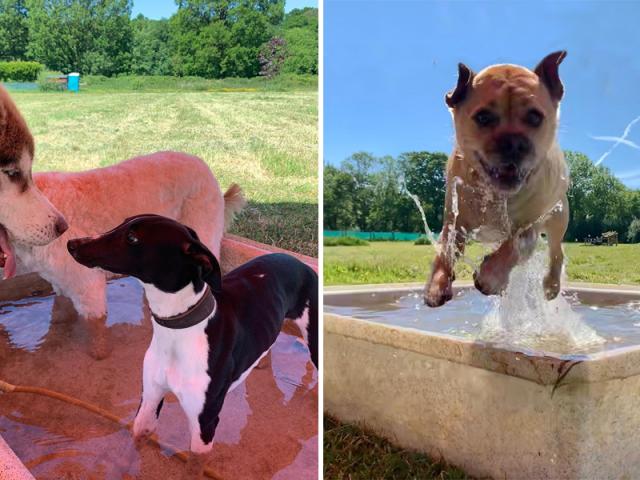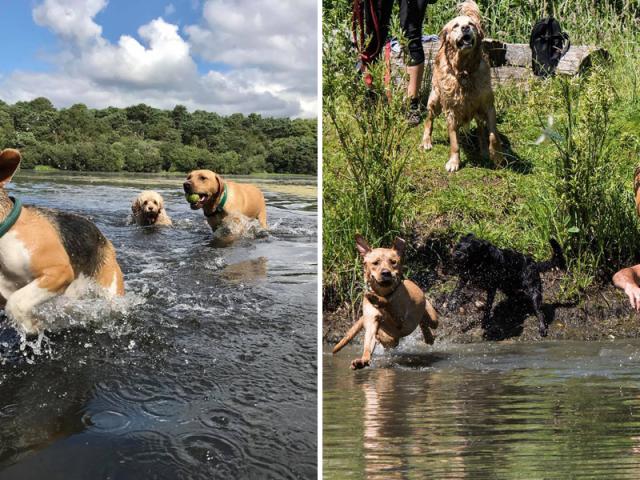As a general rule, dogs suffer much more from intense heat than humans because they do not sweat and therefore have difficulty regulating their body temperature. This can lead to dehydration and heatstroke that can have dramatic consequences for our pets. The first sign of suffering will often be intense and uninterrupted panting, sometimes accompanied by behavioural change.
Changes in behaviour
Hot weather can also cause the behaviour of your dog to change. Just as they sleep more in cold weather in the winter months, heat can also affect their sleeping pattern. Excessive heat can cause them to be more tired, drowsy, and to sleep more as they are too tired to be active.

Dogs most affected by the heat
As a general rule, dogs who are most at risk in the heat are those that weigh more than 110 pounds, older dogs, pregnant dogs, dogs who are already unwell, and also breeds with flat faces.
Breeds at increased risk include: Bulldogs, French Bulldogs, Boxers, Pugs, Chow Chows, Dogue de Bordeaux, Greyhounds, English Springer Spaniels, Cavalier King Charles Spaniels, Golden Retrievers and Staffordshire Bull Terriers.
When in the sunshine, dogs with a black coat are also more at risk of over heating, as a black coat absorbs more light then a white or light coat. The energy from that light is transformed into heat, which is absorbed by the dog's body.
During heatwaves, more frequent nowadays, all dog owners are urged to keep a watchful eye on their dogs to ensure they are not put in situations leading to risks of dehydration or heatstroke.
Signs of a heatstroke
- Heavy panting, even when not exercising
- Breathing problems, particularly in flat-faced dogs
- Tiredness
- Stiffness or an unwillingness to move
- Dribbling
- Confusion
- Being sick (with or without blood)
- Upset stomach (with or without blood)
- Trouble with walking
- Collapse
If you think a dog has heatstroke, contact a vet immediately and do all you can to cool your dog down till he sees the vet.
The most common cause of heatstroke in dogs is exercising on a hot day.
When is it too hot to walk your dog?
Temperatures above 25C can be risky, and in some cases cause heatstroke to your dog. Heatstroke in dogs can happen within minutes, so the key is to avoid walking your dog in hot weather.
In hot weather, the advice is as follows :
Take your dog for a walk either very early in the morning or in the evening when temperatures are cooler. Don't walk him during the hottest parts of the day.
Keep the walk short, or bring water and a container for your dog to drink from.
Avoid walking on the pavement or road, as they store the heat and get extremely hot for your dog's paws and can burn them. Pavements and concrete can remain hot even in the evening, so it is advised that you try walking barefoot on them to gauge the temperature. If it is too hot for your feet, it is too hot for your dog's paws. Wait till the pavement is cool enough to walk your dog.
If suitable for the breed of your dog, use a harness to attach the lead to rather than attaching it to their collar which can press on the airways.
Don't walk your dog at all if it is really hot, if your dog is unwell, dehydrated, or looks lethargic.
Ways to help
You should ensure your dog always has fresh water available, but in particular in temperatures above 30°C in the shade. In these temperatures, if your dog is outdoors, you also need to ensure that he will have access to shaded grassy areas all throughout the day (lawn storing the heat a lot less than concrete or tiles). If you see it gets too hot for your dog, ensure you bring him indoors in the coolest part of your house.

The best way to cool a dog down is to wet his body using a cool wet flannel, focusing on their neck, stomach and inner thighs, and give him damp towels to lie on but never place a damp towel over your dog, as this can trap in heat.
If your dog enjoys it, this is a good time to wash or bathe your dog in the garden, then letting him dry outdoors.
Fan them with cool air or put them in an air-conditioned room or car if possible. The impact of this will be greatest if they’re already wet.
Another way, if your dog likes water, is to provide a paddling pool for him, another very good reason to try to get your dog to enjoy water. An ice pack wrapped in a towel can also offer relief.

Under no circumstances should a dog be locked alone in a car, even parked in the shade and even with the windows ajar, even for a few minutes.
If you have a medium or long haired dog, have your dog groomed regularly to brush away any dead or excess hair and make their coat less dense.
Dogstroll day care centre
Our day care centre is fully adapted for caring for dogs in hot weather. We have cool indoor areas, a lot of shaded areas outdoors, woodland area, and a pond at our disposal for dogs who like to go for a swim, and our staff happily join in. For dogs who do not feel so confident in a large area of water, we put shallow pools out in shaded areas for them to dip their paws in, lay, roll or play in. We also cool them down with the hose, which many see as a game. We also organise games in the water. Our staff will be on the lookout and adapt activities according to the weather and what's best for each dog.



